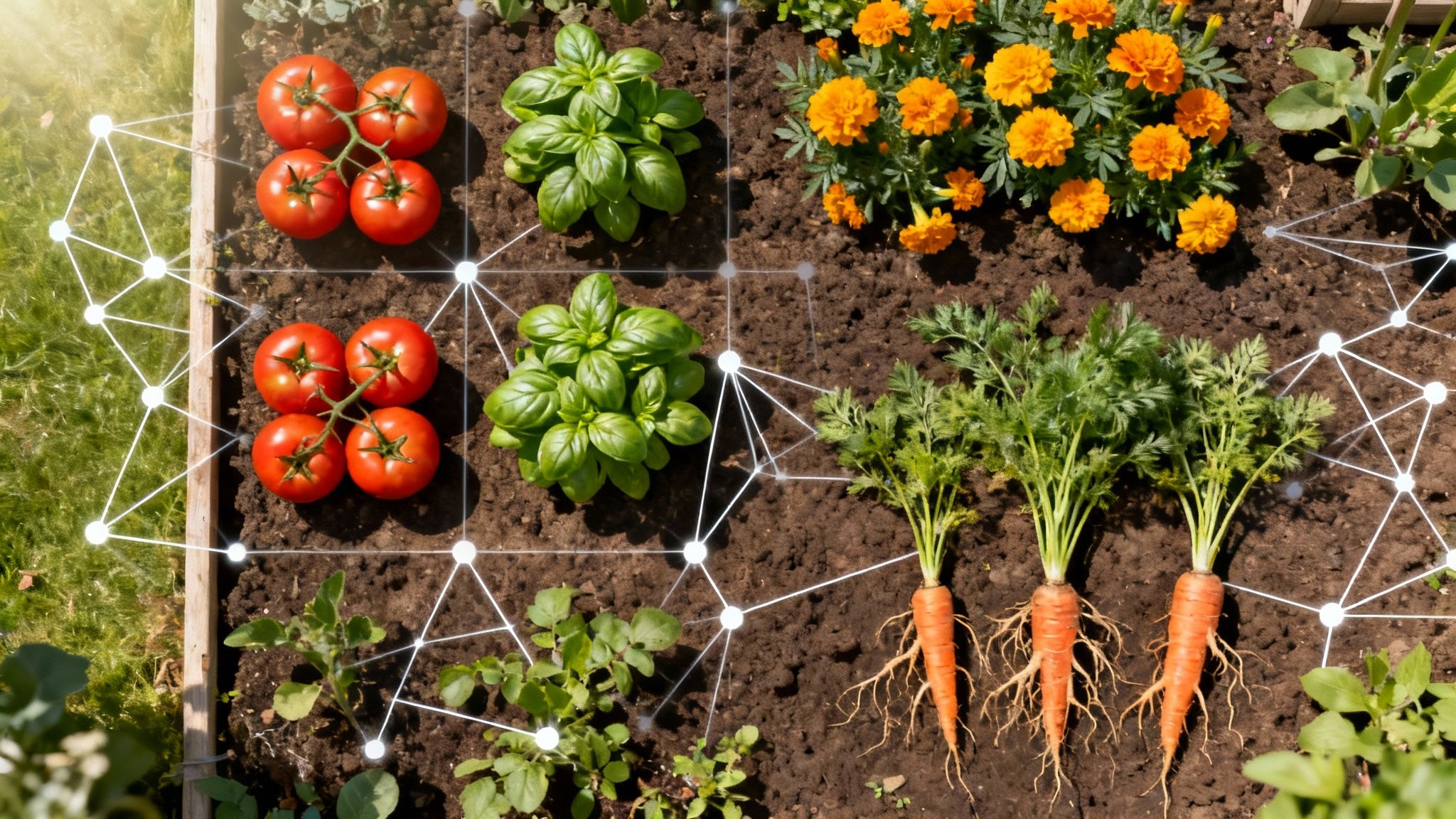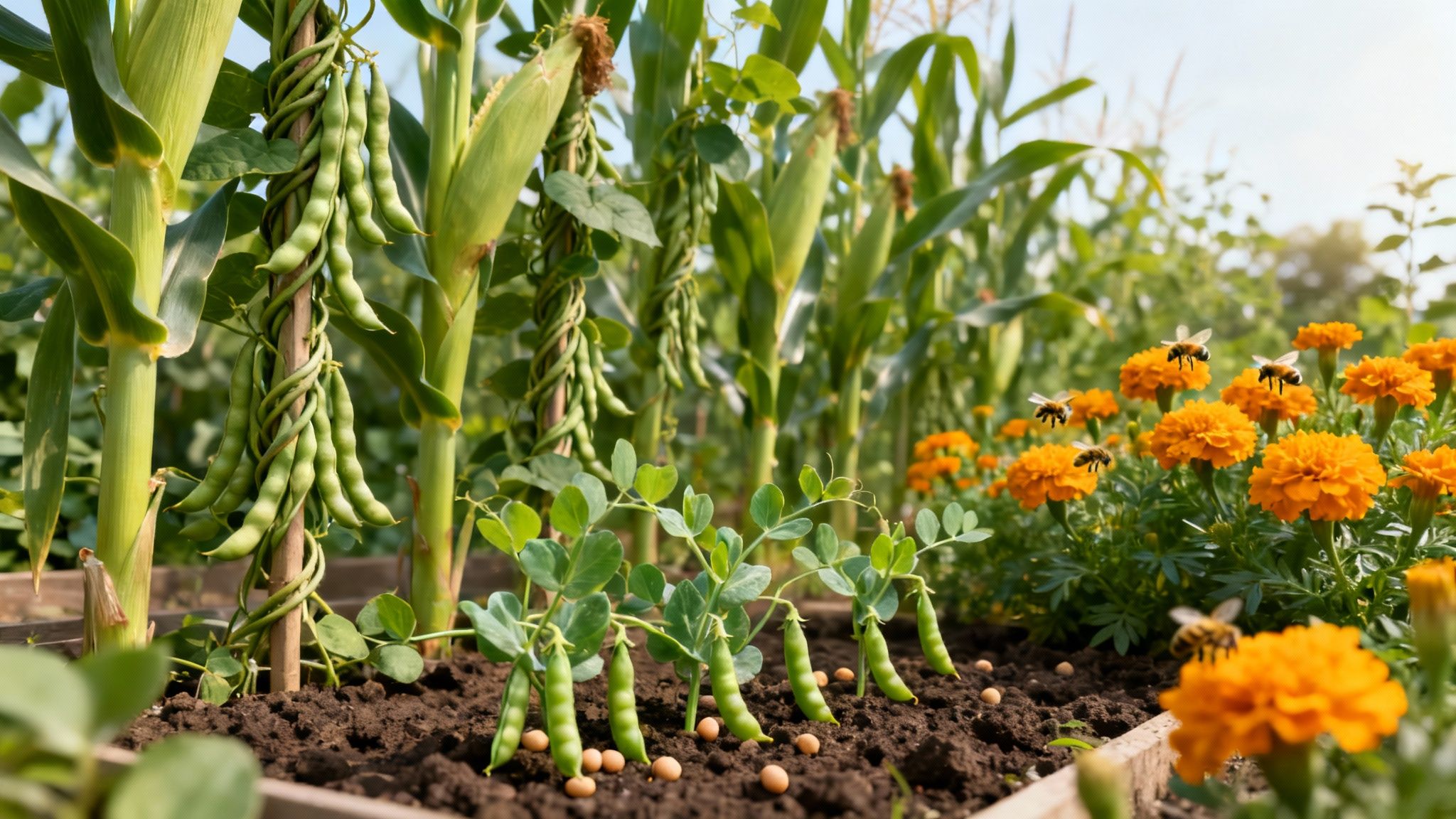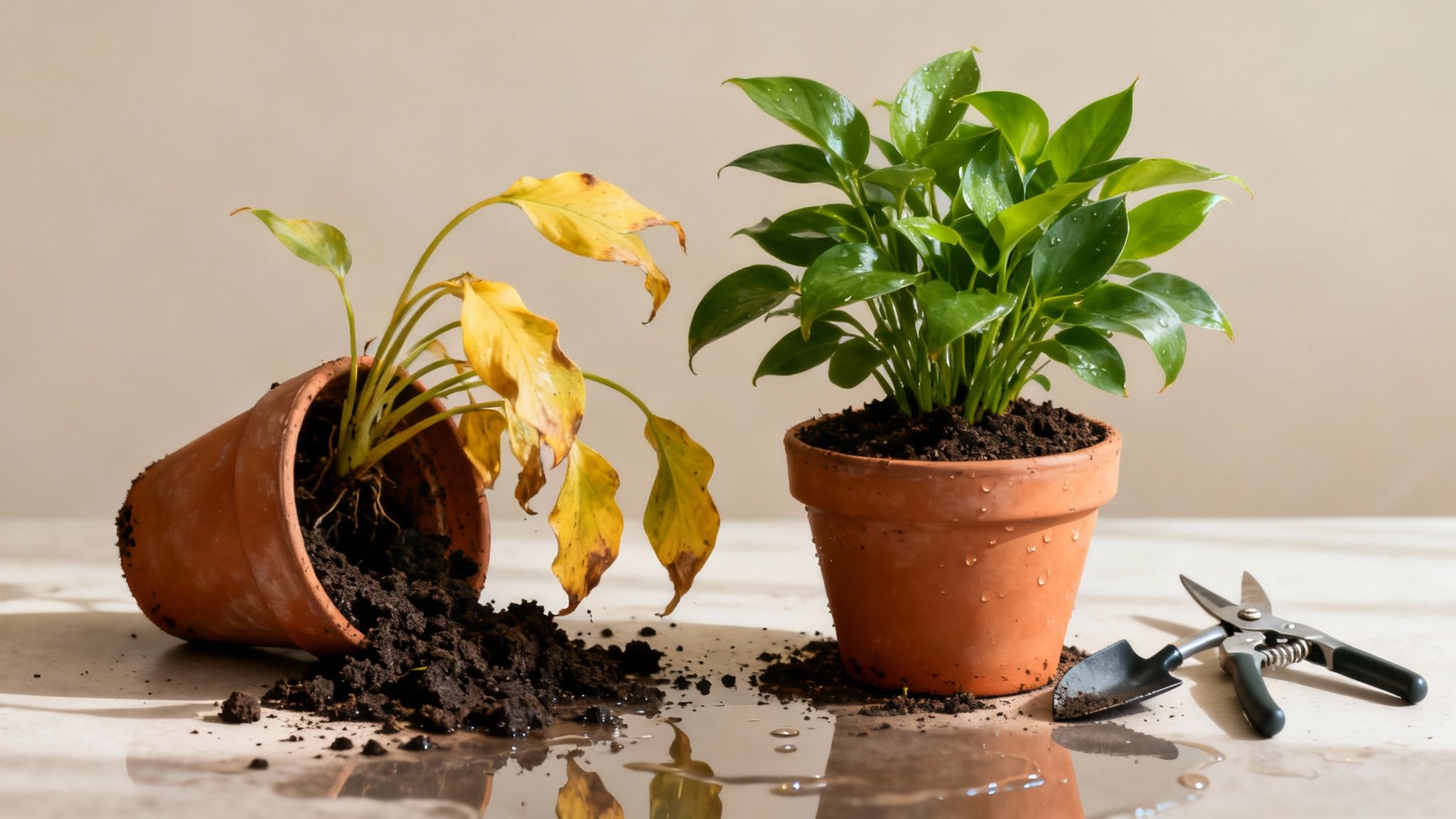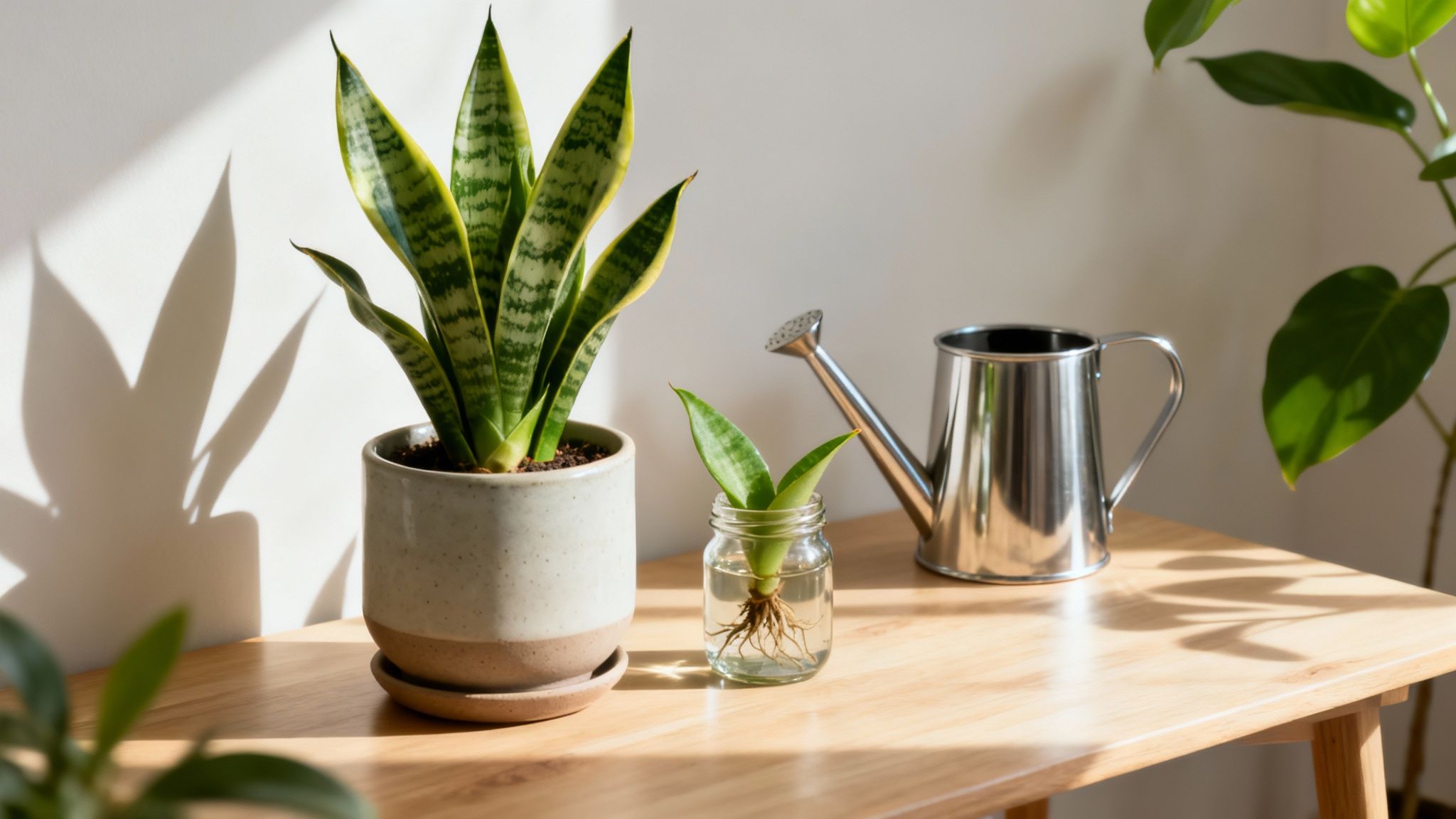Ever feel like you’re doing everything right—watering, sun, fertilizer—but your garden still isn’t thriving? The secret might not be in what you’re doing, but in who you’re planting next to whom. Your garden is a silent, bustling community where plants can be best friends or sworn enemies. Understanding these relationships is the key to creating a healthier, more productive garden without relying on synthetic chemicals.
This is the power of companion planting: a time-tested strategy that taps into natural plant partnerships to deter pests, enrich the soil, and boost your harvest. Think of it as plant matchmaking. In this guide, you’ll learn the science behind these powerful plant alliances, discover classic pairings for your vegetable and herb garden, and get practical tips to design a garden that practically takes care of itself.
The Secret Social Life of Your Plants

Your garden plot is a miniature neighborhood. When the residents get along, the whole community thrives. It’s the exact same principle with your plants. By strategically pairing them up, you unlock some incredible benefits that transform your garden into a self-sustaining ecosystem.
Natural Pest Control: Some plants, like marigolds (Tagetes spp.), release compounds from their roots that repel destructive root-knot nematodes. Others, like rosemary, emit strong scents that confuse pests looking for your prize carrots.
Attracting Helpful Allies: Certain flowers act like a neon sign for beneficial insects. Planting sweet alyssum (Lobularia maritima) attracts hoverflies, whose larvae are voracious aphid eaters, providing a natural pest patrol.
Improved Plant Health and Vigor: Legumes like beans and peas are amazing neighbors. They have the unique ability to pull nitrogen from the air and "fix" it in the soil, providing a free, natural fertilizer for hungry plants like corn or tomatoes.
Enhanced Flavor and Growth: This is a fun one. Many gardeners swear that planting basil (Ocimum basilicum) next to tomatoes actually makes the tomatoes taste better. While a delicious theory, the proven pest-repelling benefits are reason enough to try it.
This practice is so much more than old gardening folklore; it’s a smart, sustainable way to work with nature instead of against it. For more deep dives into nurturing your garden's ecosystem, feel free to explore our various plant care articles. Now, let’s get into the specifics of how these amazing plant collaborations actually work.
Unlocking Garden Synergy with Companion Planting

So, how does companion planting actually work? Instead of a dry, textbook definition, think of your garden as a team where every plant has a job. Some are bodyguards, others are soil-builders, and some even act as living infrastructure. Once you understand why these pairings work, you can move beyond simple charts and start designing truly creative and effective plant communities.
The Bodyguards: Pest Repellers
Certain plants are the neighborhood watch of your garden. They act as "bodyguards" by emitting strong scents that either confuse or repel destructive insects. This is one of the first and most obvious benefits you'll see.
Aromatic herbs are the all-stars here. Planting rosemary (Salvia rosmarinus) near your carrot patch helps mask their scent from the destructive carrot rust fly. In the same way, basil grown alongside tomatoes is famous for repelling tomato hornworms. It's a simple, organic way to protect your crops.
The Providers: Soil Enrichers
Next up are the "providers"—the generous neighbors who improve the soil for everyone. These plants, mostly from the legume family, have the incredible ability to pull nitrogen from the air and "fix" it into the soil through their roots. This makes them fantastic companions for heavy-feeding plants.
Beans and Corn: A classic partnership. The beans provide the nitrogen that greedy corn needs to produce plump ears.
Peas and Carrots: Peas enrich the soil, giving root vegetables like carrots the boost they need for strong growth.
Planting these nitrogen-fixers is like adding a slow-release, all-natural fertilizer directly into your garden beds.
The Architects: Structural Support
Some plants offer a helping hand—or stalk—by acting as living "scaffolding" for their vining neighbors. This is a brilliant way to maximize vertical space.
The most famous example is corn (Zea mays). Its tall, sturdy stalks provide the perfect natural trellis for climbing pole beans to spiral their way up to the sun. Even a large sunflower can serve as a living stake for a cucumber vine. This trick saves you from needing extra cages and creates a more integrated ecosystem.
Surprising Fact: Studies have shown that intercropping—a form of companion planting—can boost total yields by up to 30% compared to growing a single crop in the same space.
The Magnets: Pollinator Attractors
What's a garden without bees and butterflies? "Magnet" plants are the social hubs, attracting the beneficial pollinators that are essential for fruiting crops like squash, cucumbers, and even some fruit trees like avocados.
Flowers like calendula (Calendula officinalis) and borage (Borago officinalis) are pollinator powerhouses. Sprinkling them throughout your vegetable patch is like putting up a giant "Open for Business" sign, ensuring your fruiting plants get the attention they need for a bumper crop.
The Decoys: Trap Crops
Finally, some plants perform the ultimate act of service: they become "decoys." These are what we call trap crops—plants that pests find irresistible. You plant them a little ways away from your main crops to lure the bad guys away from the plants you actually want to eat.
Nasturtiums (Tropaeolum majus) are an aphid magnet. Aphids will swarm them, leaving your precious kale and peppers alone. This lets you manage the pests in one concentrated spot instead of fighting a battle across your entire garden.
Case Study: The Three Sisters Garden
Companion planting isn't some new trend; it's an ancient practice refined over millennia. And there’s no better example than the ‘Three Sisters’ method, a cornerstone of Indigenous American agriculture that functions as a complete, self-sustaining ecosystem. It’s a powerful, real-world case study proving that these principles are both time-tested and profoundly effective.
How the Three Sisters Work Together
The brilliance of this system is how each plant’s unique traits fill the needs of its neighbors. It's a masterclass in garden synergy.
Corn (Zea mays): The Supporter. The tall, sturdy corn stalks act as a natural, living trellis, giving climbing beans the crucial support they need.
Beans (Phaseolus vulgaris): The Giver. As the beans climb, they pull nitrogen from the air and "fix" it into the soil through their roots, feeding the nitrogen-hungry corn and squash.
Squash (Cucurbita pepo): The Protector. The broad, spiny leaves of the squash plant spread out to form a living mulch. This smothers weeds, holds moisture in the soil, and its prickly texture helps deter pests like raccoons.
This technique goes back thousands of years. You can learn more about the history of this and other companion planting practices.
The Measurable Impact of This Ancient Guild
The benefits of the Three Sisters aren't just stories; they translate into real, measurable boosts in garden health and yield. The chart below breaks down the specific contributions of each sister.
As you can see, the system delivers remarkable results. The nitrogen fixation from the beans is significant, and the boost to corn productivity is nothing to scoff at.
A Complete Nutritional System: The magic of the Three Sisters extends beyond the garden. Together, they form a nutritionally complete meal. Corn provides carbohydrates, beans offer rich protein, and squash delivers essential vitamins—a combination that sustained communities for centuries.
Classic Pairings for Your Vegetable & Herb Garden

Now that we’ve covered the “why” behind companion planting, let's get our hands dirty with the “who.” Some plant combinations are so reliable they’ve been passed down for generations. Here are some of the most trusted pairings for vegetables and herbs.
The Tomato and Basil Power Couple
If you try only one companion planting trick, make it this one. Tomatoes (Solanum lycopersicum) and basil are the quintessential duo. Planting basil around your tomatoes is a classic strategy to ward off the dreaded tomato hornworm and whiteflies. The strong, fragrant oils from the basil leaves can confuse these pests, sending them looking for an easier meal elsewhere.
Carrots and Their Aromatic Guardians
Root vegetables like carrots (Daucus carota) are vulnerable to low-flying pests. Giving them fragrant neighbors is like hiring a tiny security detail.
Rosemary (Salvia rosmarinus): The intense, piney aroma of rosemary is fantastic for deterring the carrot rust fly.
Chives (Allium schoenoprasum): As a member of the onion family, chives help repel aphids and other pests without blocking sunlight.
By interplanting these herbs, you create a confusing cloud of smells that makes it harder for pests to find your carrots.
Marigolds: The Universal Garden Protector
Marigolds are one of the hardest-working plants on your team. Their reputation for fighting off harmful soil nematodes is legendary. French marigolds, in particular, release a biochemical from their roots that is toxic to these microscopic pests. Studies confirm that certain companion plants can slash pest-related damage by up to 40%. You can learn more about the science of companion planting for pest management to see the data for yourself.
Practical Tip: To maximize the benefits of marigolds, plant them densely as a cover crop. At the end of the season, till them directly into the soil. This enriches your soil with organic matter while actively suppressing nematode populations for next year's garden.
The Brassica and Herb Alliance
Plants in the brassica family—broccoli (Brassica oleracea), cabbage, and kale—are magnets for cabbage moths and aphids. Aromatic herbs come to the rescue.
Dill (Anethum graveolens): Dill is great at attracting beneficial insects like ladybugs and lacewings, which have a huge appetite for aphids.
Thyme (Thymus vulgaris): This low-growing herb helps deter the cabbage worm, a caterpillar that can turn beautiful brassica leaves into Swiss cheese overnight.
**Mint (**Mentha** spp.):** Mint is a champion at repelling cabbage moths but is an incredibly aggressive spreader. Always plant it in a separate container sunk into the garden bed to keep its roots from taking over.
Companion Planting for Trees
This concept isn't just for annual vegetables. You can apply the same principles to fruit trees like avocados or figs. Planting nitrogen-fixers like clover at the base of a young tree can provide a steady supply of nutrients. Flowering herbs like comfrey and borage attract pollinators crucial for fruit set and can also help accumulate minerals in the soil.
Real-World Application: Sarah's Urban Garden
Let’s imagine Sarah from Portland, who has a small backyard plot. Last year, her tomatoes were decimated by hornworms and her kale was overrun with aphids. It was a frustrating season.
This year, she decides to try companion planting.
The Problem: Pests overwhelming her key crops.
The Solution: She plants basil all around her tomato plants. Next to her kale, she plants a row of dill to attract ladybugs and a border of nasturtiums a few feet away to act as a trap crop for the aphids.
The Result: The strong scent of basil confuses the hornworm moths, and she only finds one all season. The aphids flock to the "sacrificial" nasturtiums, leaving her kale almost untouched. The dill brings in so many ladybugs they become a permanent pest patrol. Sarah enjoys her best harvest yet, all by working with nature. This is where getting hyper-local advice is a game-changer. Using a feature like Tendra’s Twin Plant Mates connects you with gardeners in your area to see what companion strategies are actually working in your climate, solving problems just like Sarah's.
Your Thriving Garden Community Awaits
We've dug into everything from ancient traditions like the Three Sisters to modern-day applications in your backyard, and the takeaway is clear: companion planting is a smart, sustainable strategy any gardener can master.
It’s about becoming the architect of a tiny, cooperative ecosystem. When you get the pairings right, you can reduce pests, enrich your soil, and get a bigger, better harvest. But you don't have to figure it all out alone. The real magic happens when you connect with a community to share what worked and learn from others who have solved the exact same problems. Imagine getting advice from gardeners who’ve already figured out the pest you're dealing with in your specific climate.
Discover the best plant partners for your garden with Tendra—where local gardeners connect and thrive. Download the app to get started.












